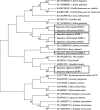Adaptation mechanism of three Impatiens species to different habitats based on stem morphology, lignin and MYB4 gene
- PMID: 38789944
- PMCID: PMC11127381
- DOI: 10.1186/s12870-024-05115-3
Adaptation mechanism of three Impatiens species to different habitats based on stem morphology, lignin and MYB4 gene
Abstract
Background: Impatiens is an important genus with rich species of garden plants, and its distribution is extremely extensive, which is reflected in its diverse ecological environment. However, the specific mechanisms of Impatiens' adaptation to various environments and the mechanism related to lignin remain unclear.
Results: Three representative Impatiens species,Impatiens chlorosepala (wet, low degree of lignification), Impatiens uliginosa (aquatic, moderate degree of lignification) and Impatiens rubrostriata (terrestrial, high degree of lignification), were selected and analyzed for their anatomical structures, lignin content and composition, and lignin-related gene expression. There are significant differences in anatomical parameters among the stems of three Impatiens species, and the anatomical structure is consistent with the determination results of lignin content. Furthermore, the thickness of the xylem and cell walls, as well as the ratio of cell wall thickness to stem diameter have a strong correlation with lignin content. The anatomical structure and degree of lignification in Impatiens can be attributed to the plant's growth environment, morphology, and growth rate. Our analysis of lignin-related genes revealed a negative correlation between the MYB4 gene and lignin content. The MYB4 gene may control the lignin synthesis in Impatiens by controlling the structural genes involved in the lignin synthesis pathway, such as HCT, C3H, and COMT. Nonetheless, the regulation pathway differs between species of Impatiens.
Conclusions: This study demonstrated consistency between the stem anatomy of Impatiens and the results obtained from lignin content and composition analyses. It is speculated that MYB4 negatively regulates the lignin synthesis in the stems of three Impatiens species by regulating the expression of structural genes, and its regulation mechanism appears to vary across different Impatiens species. This study analyses the variations among different Impatiens plants in diverse habitats, and can guide further molecular investigations of lignin biosynthesis in Impatiens.
Keywords: Impatiens; MYB4 gene; Expression analysis; Lignin; Stem morphological anatomy.
© 2024. The Author(s).
Conflict of interest statement
The authors declare no competing interests.
Figures





Similar articles
-
Variation of morphological structure, lignin and MYB61 gene revealed the adaptation of three Impatiens to different habitats.Plant Sci. 2025 Oct;359:112623. doi: 10.1016/j.plantsci.2025.112623. Epub 2025 Jun 24. Plant Sci. 2025. PMID: 40571104
-
Hevea brasiliensis coniferaldehyde-5-hydroxylase (HbCAld5H) regulates xylogenesis, structure and lignin chemistry of xylem cell wall in Nicotiana tabacum.Plant Cell Rep. 2021 Jan;40(1):127-142. doi: 10.1007/s00299-020-02619-8. Epub 2020 Oct 17. Plant Cell Rep. 2021. PMID: 33068174 Free PMC article.
-
Transcriptome profiling of Brassica napus stem sections in relation to differences in lignin content.BMC Genomics. 2018 Apr 16;19(1):255. doi: 10.1186/s12864-018-4645-6. BMC Genomics. 2018. PMID: 29661131 Free PMC article.
-
Modifying crops to increase cell wall digestibility.Plant Sci. 2012 Apr;185-186:65-77. doi: 10.1016/j.plantsci.2011.10.014. Epub 2011 Oct 25. Plant Sci. 2012. PMID: 22325867 Review.
-
MYB Transcription Factors and Its Regulation in Secondary Cell Wall Formation and Lignin Biosynthesis during Xylem Development.Int J Mol Sci. 2021 Mar 30;22(7):3560. doi: 10.3390/ijms22073560. Int J Mol Sci. 2021. PMID: 33808132 Free PMC article. Review.
Cited by
-
Integrative Targeted Metabolomics and Transcriptomics Reveal the Mechanism of Leaf Coloration in Impatiens hawkeri 'Sakimp005'.Int J Mol Sci. 2024 Dec 28;26(1):174. doi: 10.3390/ijms26010174. Int J Mol Sci. 2024. PMID: 39796032 Free PMC article.
References
MeSH terms
Substances
LinkOut - more resources
Full Text Sources
Miscellaneous

